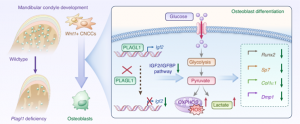Understanding Jaw Growth: Key Gene Axis Controls Postnatal Condyle Development
New research identifies PLAGL1-IGF2 as crucial regulators of mandibular bone growth after birth
BEIJING, BEIJING, CHINA, October 22, 2025 /EINPresswire.com/ -- A study published in the International Journal of Oral Science reveals that the PLAGL1-IGF2 axis plays a vital role in postnatal jaw development. Using a mouse model, researchers showed that PLAGL1 regulates osteoblast differentiation in cranial neural crest cell-derived condyles. Deficiency in PLAGL1 disrupts bone formation, but treatment with IGF2 can rescue this effect. These findings provide new insights into craniofacial development and potential therapeutic targets for mandibular disorders.The mandibular condyle is a central growth site in the jaw, essential for chewing, speaking, and overall facial structure. Proper development of this region relies on a finely tuned network of genes and growth factor signaling pathways. Despite its importance, the molecular mechanisms controlling postnatal condyle osteogenesis have remained largely unclear.
“Understanding the regulatory mechanisms involved in condyle development could provide valuable insights for developing targeted therapeutic strategies for craniofacial abnormalities,” highlights Professor Xinquan Jiang, who led the group that worked in this direction. In this study, researchers investigated the role of PLAGL1, a paternally expressed zinc finger transcription factor, in postnatal condyle development. PLAGL1 is highly expressed in cranial neural crest cell-derived lineage cells in mouse condyles, suggesting a critical function in osteogenic differentiation. To test this, the team generated a lineage-specific Plagl1 knockout mouse model, allowing them to evaluate its impact on condyle growth. The study was published online in the International Journal of Oral Science on September 25, 2025.
The results were striking. Mice lacking PLAGL1 in condylar cells exhibited impaired osteoblast differentiation, disrupted extracellular matrix organization, and defective ossification. These deficits led to altered mandibular condyle development, highlighting PLAGL1’s essential role in guiding postnatal jaw growth. Mechanistic studies further revealed that PLAGL1 exerts its effects through the insulin-like growth factor 2 (IGF2) pathway, working in conjunction with IGF-binding proteins (IGFBPs) to regulate osteogenesis. Plagl1 deficiency downregulated this pathway, resulting in disrupted glucose metabolism and diminished bone formation. Importantly, exogenous IGF2 treatment rescued the impaired differentiation of osteoblasts caused by the absence of PLAGL1, confirming the functional importance of this axis.
The study emphasizes the broader significance of imprinted genes in craniofacial development. Imprinted genes like PLAGL1 are expressed from only one parental allele, and their precise regulation is crucial for normal growth and differentiation. This research demonstrates that PLAGL1 is not only a key regulator of postnatal condyle development but also acts through a specific molecular pathway that could be targeted therapeutically.
These findings have potential clinical implications. Disorders of mandibular condyle growth can result in abnormal jaw alignment, facial asymmetry, and difficulties with chewing or speech. Understanding the PLAGL1-IGF2 axis offers a foundation for developing interventions aimed at promoting normal bone growth or correcting developmental anomalies. Additionally, insights from this study may inform regenerative strategies in craniofacial reconstruction and repair.
The research also provides a valuable model for studying other aspects of craniofacial bone development. By linking gene expression, signaling pathways, and cellular differentiation, the team highlights the complex coordination required for skeletal maturation after birth. This work underscores the potential of molecular biology approaches to uncover the genetic and biochemical foundations of organ development.
Overall, this study sheds light on a previously underappreciated genetic mechanism controlling postnatal mandibular condyle osteogenesis. The PLAGL1-IGF2 axis emerges as a critical driver of jaw bone formation, offering opportunities for therapeutic exploration and a deeper understanding of craniofacial biology. “Our findings provide new insights into craniofacial development and potential therapeutic targets for mandibular disorders,” concludes Prof. Jiang. Future studies will likely investigate how modulation of this pathway could support the treatment of developmental disorders and improve outcomes in craniofacial medicine.
***
Reference
Titles of original papers: PLAGL1-IGF2 axis regulates osteogenesis of postnatal condyle development
Journal: International Journal of Oral Science
DOI: http://doi.org/10.1038/s41368-025-00386-4
About Professor Xinquan Jiang
Xinquan Jiang is a professor at the Department of Prosthodontics, Shanghai Ninth People’s Hospital, and the College of Stomatology, Shanghai Jiao Tong University. He specializes in prosthodontics and regenerative medicine, focusing on bone regeneration and oral function restoration. Professor Jiang has led numerous national and international research projects, authored over 130 peer-reviewed publications, and contributed significantly to advances in oral and craniofacial science through both clinical and experimental research.
Yini Bao
International journal of oral science
+86 13318133745
ijos@scu.edu.cn
Legal Disclaimer:
EIN Presswire provides this news content "as is" without warranty of any kind. We do not accept any responsibility or liability for the accuracy, content, images, videos, licenses, completeness, legality, or reliability of the information contained in this article. If you have any complaints or copyright issues related to this article, kindly contact the author above.

